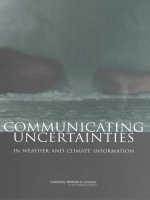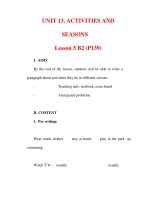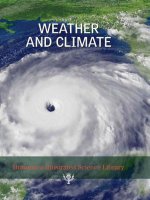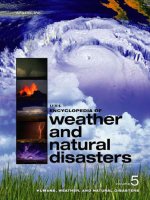Earths weather and seasons
Bạn đang xem bản rút gọn của tài liệu. Xem và tải ngay bản đầy đủ của tài liệu tại đây (2.3 MB, 14 trang )
Earth Science
by Ann J. Jacobs
Genre
Nonfiction
Comprehension Skill
Draw Conclusions
Text Features
• Captions
• Diagram
• Glossary
Science Content
Weather
Scott Foresman Science 2.6
ISBN 0-328-13784-7
ì<(sk$m)=bdhiei< +^-Ä-U-Ä-U
Vocabulary
condense
What did Earth’s
you learn?
Weather
1. What happens to plants in the fall?
and Seasons
evaporate
2. What do animals do when they migrate?
hibernate
3.
Write to explain what this means. Use words
from the book as you write.
hurricane
lightning
migrate
tornado
water cycle
Photographs: Every effort has been made to secure permission and provide appropriate credit for
photographic material. The publisher deeply regrets any omission and pledges to correct errors called to its
attention in subsequent editions. Unless otherwise acknowledged, all photographs are the property of Scott
Foresman, a division of Pearson Education. Photo locators denoted as follows: Top (T), Center (C), Bottom
(B), Left (L), Right (R) Background (Bkgd)
Opener: (Bkgd) ©Jim Zuckerman/Corbis; (TC) ©Taxi/Getty Images; ©Macduff Everton/Corbis, (TR)
Getty Images; (Bkgd) ©Bill Ross /Corbis; Title Page: ©The Image Bank/Getty Images; 2 (Bkgd) ©Otto
Rogge/Corbis, ©Bill Ross/Corbis; 3 © DK Images; 4 (CL) ©Richard Hamilton Smith/Corbis, (CR) ©Phil
Schermeister/NGS Image Collection; 5 ©Stone/Getty Images; 6 ©Sam Abell/NGS Image Collection;
8 (B) ©Photographer’s Choice/Getty Images, ©Tom Brakefield /Corbis; 9 (BL) ©The Image Bank/Getty
Images, (T) ©Dennis MacDonald/PhotoEdit, (BR) ©Taxi/Getty Images; 10 ©John Conrad/Corbis; 11 (TL)
©James Schwabel/Panoramic Images, Chicago, (TR) ©Michael Boys/Corbis, (CC) ©D. Robert and Lorri
Franz/Corbis; 12 ©Gary W. Carter/Corbis; 13 (TL) ©Stone/Getty Images, ©Lowell Georgia/Corbis;
14 ©Marty Stoufer/Animals Animals/Earth Scenes; 15 (TL) ©Photographer’s Choice/Getty Images, (CL)
©Photodisc Green/Getty Images, (CL) ©Comstock Images/Getty Images; 17 ©A & J Verkaik/Corbis;
19 ©Alan. R. Moller/Getty Images; 21 ©The Image Bank/Getty Images; 22 (BR) ©James Schwabel/
Panoramic Images, Chicago, (T) ©The Image Bank/Getty Images; 23 ©Photodisc Green/Getty Images.
ISBN: 0-328-13784-7
Copyright © Pearson Education, Inc.
All Rights Reserved. Printed in the United States of America. This publication is
protected by Copyright and permission should be obtained from the publisher prior
to any prohibited reproduction, storage in a retrieval system, or transmission in any
form by any means, electronic, mechanical, photocopying, recording, or likewise. For
information regarding permissions, write to: Permissions Department, Scott Foresman,
1900 East Lake Avenue, Glenview, Illinois 60025.
3 4 5 6 7 8 9 10 V010 13 12 11 10 09 08 07 06 05
moves in a cycle.
by Ann J.Water
Jacobs
4.
Draw Conclusions Which do you
think is more dangerous, a thunderstorm or a
tornado? Why?
What are some kinds
of weather?
You wake up.
How do you know what to put on?
Check the weather!
Weather is what it is like outside.
Is it hot, or is it cold?
Look up at the sky.
Look at the tree branches.
Are they moving?
Is there wind?
Flying a kite on a
windy day is fun!
2
3
Wet and Dry Weather
Rain, sleet, and snow are all wet weather.
Clouds help tell what kind of weather is
coming.
Clouds are made of many drops of water.
When the clouds get full, the drops fall.
Water from clouds can fall as rain, snow,
or sleet.
Snow and sleet fall when the air is cold.
Rain falls when the air is warm.
Sometimes rain does not fall for a long time.
This is called a drought.
There is no water for plants and animals
when this happens.
Some plants cannot
live in a drought.
Some places get snow
in winter.
Heavy rains can fall in
spring and summer.
4
5
What is the water cycle?
Water moves in a circle.
This is called the water cycle.
Water falls from clouds to Earth.
Then it moves back up to the clouds.
Look at the four steps of the water cycle.
1. Water falls from the
clouds. It can be rain,
snow, or sleet.
2. Water goes into rivers,
lakes, and oceans.
4. Water vapor gets cold.
It condenses into clouds.
Condense means to change
back into drops of water.
3. The Sun makes
some of the water
evaporate.
It changes into
water vapor.
6
7
What is spring?
Weather can change with the seasons.
Some spring days are cool.
Some spring days are warm or rainy.
Plants grow in the spring.
Many animals have babies.
A deer and her
baby in the spring.
8
9
What is summer?
Summer comes after spring.
Summer can have hot days and
warm nights.
Green leaves grow on many trees
and plants.
Flowers, fruits, and vegetables grow.
You can see animal
families in the summer.
10
11
What is fall?
Fall comes after summer.
In fall the air gets cooler.
Some leaves change colors.
Some animals look for food for the winter.
Other animals migrate, or go to a
warmer place.
In fall, some
animals find food
for the winter.
12
13
What is winter?
Winter comes after fall.
Winter can be very cold.
It may snow.
Ponds and streams may turn to ice.
Some animals hibernate.
They sleep all winter and wake up in
the spring.
Bears hibernate
in the winter.
14
15
What are some kinds
of bad weather?
Thunderstorm Safety!
A thunderstorm is one kind of bad weather.
A thunderstorm has lots of wind and rain.
A thunderstorm has thunder.
It has lightning.
Lightning is a flash of light in the sky.
• Keep away from water.
• Go inside.
• Keep away from things made
of metal.
• Do not stand under a tree.
• Do not use a phone.
• Keep away from electrical things.
16
17
Tornadoes
Tornado Safety!
A tornado is a very strong wind.
A tornado comes down from the clouds.
It looks like a funnel.
• Get inside a closet or a bathroom.
A tornado breaks everything in its path.
• Sit under the stairs.
• Keep away from windows.
• Keep away from water.
• Keep away from things made of
metal and things that are electric.
• Cover your head.
• If you are outside, lie flat on
the ground.
18
19
Hurricanes
Hurricane Safety!
A hurricane is a big storm.
A hurricane starts over warm ocean water.
The rain from a hurricane can make a flood.
• Move to a place away from
the ocean.
A hurricane has strong winds.
The winds can blow down trees and buildings.
• Cover up windows.
• Bring things inside.
• Keep drinking water with you.
• Make sure your flashlight and
radio work.
• Stay inside.
• Stay away from windows.
20
21
Weather changes from season to season.
Some weather is wet.
Some weather is dry.
Some weather is hot.
Some weather is cold.
22
Some weather is not safe.
Some weather is fun.
What is the weather like today?
23
Vocabulary
Glossary
condense
condense
What did you learn?
1. What happens to plants in the fall?
evaporate
to change into small drops of
water
hibernate
evaporate
to change into water vapor
3.
hurricane
hibernate
lightning
to have a long, deep sleep
during winter
Water moves in a cycle.
Write to explain what this means. Use words
from the book as you write.
4.
migrate
hurricane
tornado
a strong windstorm that starts
over warm ocean water
Draw Conclusions Which do you
think is more dangerous, a thunderstorm or a
tornado? Why?
water cycle
lightning
a flash of light in the sky
migrate
tomade
move
a warmer
place
Photographs: Every effort has been
to secure to
permission
and provide appropriate
credit for
photographic material. The publisher deeply regrets any omission and pledges to correct errors called to its
attention in subsequent editions. Unless otherwise acknowledged, all photographs are the property of Scott
Foresman, a division of Pearson Education. Photo locators denoted as follows: Top (T), Center (C), Bottom
(B), Left (L), Right (R) Background (Bkgd)
Opener: (Bkgd) ©Jim Zuckerman/Corbis; (TC) ©Taxi/Getty Images; ©Macduff Everton/Corbis, (TR)
Getty Images; (Bkgd) ©Bill Ross /Corbis; Title Page: ©The Image Bank/Getty Images; 2 (Bkgd) ©Otto
Rogge/Corbis, ©Bill Ross/Corbis; 3 © DK Images; 4 (CL) ©Richard Hamilton Smith/Corbis, (CR) ©Phil
Schermeister/NGS Image Collection; 5 ©Stone/Getty Images; 6 ©Sam Abell/NGS Image Collection;
8 (B) ©Photographer’s Choice/Getty Images, ©Tom Brakefield /Corbis; 9 (BL) ©The Image Bank/Getty
Images, (T) ©Dennis MacDonald/PhotoEdit, (BR) ©Taxi/Getty Images; 10 ©John Conrad/Corbis; 11 (TL)
©James Schwabel/Panoramic Images, Chicago, (TR) ©Michael Boys/Corbis, (CC) ©D. Robert and Lorri
Franz/Corbis; 12 ©Gary W. Carter/Corbis; 13 (TL) ©Stone/Getty Images, ©Lowell Georgia/Corbis;
14 ©Marty Stoufer/Animals Animals/Earth Scenes; 15 (TL) ©Photographer’s Choice/Getty Images, (CL)
©Photodisc Green/Getty Images, (CL) ©Comstock Images/Getty Images; 17 ©A & J Verkaik/Corbis;
19 ©Alan. R. Moller/Getty Images; 21 ©The Image Bank/Getty Images; 22 (BR) ©James Schwabel/
Panoramic Images, Chicago, (T) ©The Image Bank/Getty Images; 23 ©Photodisc Green/Getty Images.
tornado
a strong wind that comes down
from the clouds
water cycle
the way water moves from the
clouds to Earth and back to the
clouds
ISBN: 0-328-13784-7
Copyright © Pearson Education, Inc.
All Rights Reserved. Printed in the United States of America. This publication is
protected by Copyright and permission should be obtained from the publisher prior
to any prohibited reproduction, storage in a retrieval system, or transmission in any
form by any means, electronic, mechanical, photocopying, recording, or likewise. For
information regarding permissions, write to: Permissions Department, Scott Foresman,
1900 East Lake Avenue, Glenview, Illinois 60025.
3 4 5 6 7 8 9 10 V010 13 12 11 10 09 08 07 06 05
24
2. What do animals do when they migrate?


![extreme weather and financial markets [electronic resource] opportunities in commodities and futures](https://media.store123doc.com/images/document/14/y/ok/medium_okc1401382446.jpg)






